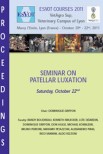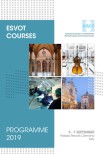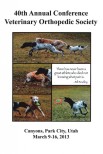
Prof. Dr. Bernadette Van Ryssen Dep. of Medical Imaging & Small Animal Orthopaedics Faculty of Veterinary Medicine GHENT UNIVERSITY Belgium
G.S-S.
I know that you have been diagnosing and treating the condition of Fragmented Coronoid Process for some years and that by now you must have a considerable number of case records to be able to have an informed opinion.
Can you tell how many cases are on record in the Clinic at Ghent? And have you formed an opinion as to whether treating the condition via arthroscopy, as opposed to arthrotomy, produces significantly different results?
BvR.
At our institution, we have been performing elbow arthroscopies since 1990. At the time of writing, we have treated about 2300 dogs for unilateral or bilateral FCP.
In my opinion, arthroscopy allows more accurate treatment because it permits clear visualisation of minimal lesions, or lesions that are barely visible during an arthrotomy. Sometimes, fragmentation may extend laterally, which can be difficult to visualize via an open approach. Additionally, subchondral bone lesions may be present without obvious cartilage lesions. Careful arthroscopic inspection and controlled palpation helps to detect those lesions. However, when an arthroscopy is not performed properly and correctly, the subsequent results are often not acceptable; incomplete fragment removal or excessive iatrogenic lesions are typical mistakes made by beginners and lead to unsatisfactory results. Thus, it is not only a matter of technique but also of skills and experience. In rare cases I have had to switch from arthroscopy to arthrotomy because the joint space was too small or the fragment too far displaced cranially to permit successful removal.
The matter of evaluating results is a very delicate matter and are compounded by the beliefs of the surgeon. My experience is that about 60% of the dogs recover completely, 35% show an occasional or constant light to moderate lameness and 5% do not improve. Long-term results have showed that 30% of the dogs appear to completely recover and donot display any signs of lameness, which is not a bad outcome for old large breed dogs. Some studies report a success rate of more than 90%. One has to ask oneseIf whether this because of a better technique or different methods of evaluation?
G.S-S.
How do you rate your opinion as to the recovery from the lameness caused by the initial condition? That is: do you use a force-plate, treadmill or some other system?
BvR
Until now, the evaluation of our results was based on the owners’ experiences and opinions, in addition to clinical examinations and follow-up radiographs. Recently we started to evaluate recovery by means of a pressure plate. When compared to the force plate, that system is easily applicable under clinical conditions.
However, as with the force plate, interpretation of the pressure plate is not that simple! Although there is a strong tendency to ‘prove’ results with gait analysis, I think the 'old fashioned' clinical examination is still valuable, provided its evaluation is objective. To be honest, I think kinematics and kinetics are complex subjects and I am somehow disappointed because of their low applicability under clinical circumstances.















